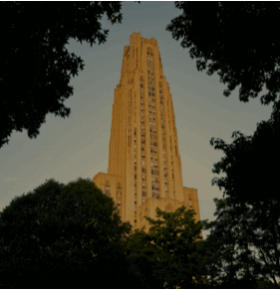
Subscribe to Pittwire Today
Get the most interesting and important stories from the University of Pittsburgh.Frank Floyd Hightower caught the shutterbug at an early age.
He worked in the darkroom, at weddings and on other assignments alongside his father, Frank Russell Hightower, who worked for more than 20 years as a public relations photographer for Allegheny County and as a freelancer photographing local events.
Around 1960, a teenage Hightower bought his first camera, an Ansco that used 620 roll film, with the money he made selling the Pittsburgh Post-Gazette newspaper at a stand at the end of the Sixth Street Bridge. The paper was in high demand as it was filled with news of the Pittsburgh Pirates and their journey to victory over the New York Yankees in the World Series.
Hightower became more seriously interested in photography as a student at Oliver High School, when his father passed down his own Minolta twin lens camera. The camera became an important tool for the student-athlete after he suffered an injury in the high jump and could no longer compete in track and field — Hightower stayed close to his teammates by photographing their practices and competitions, and his passion for photography grew.
Before graduating in 1963, he took scores of photographs for the yearbook, the school newspaper and even won a few awards and citations for his photography.
At Oliver, Hightower’s love of photography was nurtured by physics teacher Eugene Paseoff, who ran the Camera Club, and Frank Ross, an art teacher and ceramicist who introduced the burgeoning artist to photography as a fine art as well as a way to convey ideas, emotions and creative expression.
But as Hightower came of age in the late 1960s, he was also deeply affected by the social and political change swirling around him. The Black Arts Movement, which believed arts could educate and spread pride, was particularly influential.
Hightower befriended a group of young men who began to share their ideas. Known as the Centre Avenue Poets, a group that included Rob Penny, who eventually taught at University of Pittsburgh; and August Wilson, who became a Pulitzer Prize-winning playwright. Hightower also began to attend the Kuntu Writers Workshop, a practicum run by Pitt’s Africana Studies department, where anyone in the community could gather for encouragement, guidance and feedback on their writing.
Through mentorship from the poets and Kuntu, Hightower began to write his own plays, once being coached by dramaturg and theater scholar Paul Carter Harrison. His writing explored African culture, and he became greatly interested in African traditional religions.
But documenting the people and everyday life of the Black community remained his highest passion. As he was out and about, his camera of choice in the early part of his career was the same Minolta twin lenses 120 roll film camera his father passed down.
As he moved about Pittsburgh, his emerging political and social consciousness gave him “a new eye in how he saw people.” After graduating from the Antonelli School of Photography in Philadelphia, Hightower began to focus on portraiture, using his photography to showcase how people represented their culture through dress, hair and style.
Every day, everywhere he went, Hightower had his camera. And he captured a vibrant, changing community: of civil rights figures, people in the crowd at arts festivals, friends. Many of those he photographed were familiar, ordinary people who became celebrated, extraordinary figures, such as Sala Udin, a Pittsburgh political leader, and Jake Milliones, a former Pittsburgh school board member.
Often, as he roamed, he found himself at the same scenes with legendary Pittsburgh Courier photographer, Charles “Teenie” Harris. He observed and learned from Harris, but Hightower always knew his own images were just as significant for their storytelling and documentation of life.
Hightower’s huge trove of images are now part of the University of Pittsburgh Library System’s (ULS) Archives and Special Collections. His work documents the Black community and Pittsburgh from the 1960s to present, including the Kuntu Repertory Theater, the Black Horizon Theater and August Wilson’s funeral as well as scenes and events in Pittsburgh neighborhoods, including Homewood, the Hill District and his native Manchester. ULS also houses his father’s photographs in the Frank Russell Hightower Photograph Collection.
It was difficult task, but Hightower chose a few of his favorite images from the collection and shared a backstory for each.






Top photo by Aimee Obidzinski, archival photography courtesy of the University Library System


